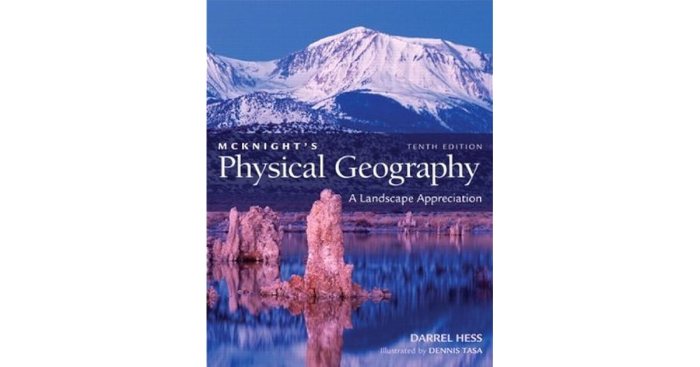Mcknight’s physical geography a landscape appreciation 12th edition – Embark on a captivating journey through McKnight’s Physical Geography: A Landscape Appreciation, 12th Edition, a comprehensive exploration of the intricate tapestry of Earth’s physical landscapes. This authoritative text invites readers to delve into the fundamental principles and concepts that shape our planet’s diverse ecosystems, unveiling the profound interplay between humans and their environment.
McKnight’s Physical Geography masterfully weaves together scientific rigor and engaging narrative, providing a panoramic view of the forces that have molded our planet’s surface. From towering mountains to vast oceans and sprawling deserts, the text illuminates the intricate interplay between geology, climate, and life, showcasing how these elements have shaped the landscapes we inhabit.
Introduction

Physical geography is the study of the Earth’s physical features, including its landforms, climate, and ecosystems. McKnight’s Physical Geography: A Landscape Appreciation, 12th Edition, is a comprehensive textbook that provides an overview of this field. The book is written in a clear and engaging style, and it is illustrated with numerous maps, photographs, and diagrams.
The Physical Landscape: Mcknight’s Physical Geography A Landscape Appreciation 12th Edition
The physical landscape is the result of the interaction between the Earth’s surface and its atmosphere. The major concepts and principles of physical geography include:
- Plate tectonics: The theory that the Earth’s crust is divided into a number of plates that move relative to each other.
- Geomorphology: The study of the Earth’s landforms.
- Climatology: The study of the Earth’s climate.
- Biogeography: The study of the distribution of plants and animals on the Earth’s surface.
Types of Landscapes
There are many different types of landscapes on the Earth’s surface, including:
- Mountains
- Hills
- Plains
- Deserts
- Forests
- Grasslands
Geologic Processes
The physical landscape is constantly being shaped by geologic processes, such as:
- Erosion: The wearing away of the Earth’s surface by wind, water, and ice.
- Deposition: The accumulation of sediment on the Earth’s surface.
- Volcanism: The eruption of magma from the Earth’s interior.
- Earthquakes: The shaking of the Earth’s surface caused by the movement of tectonic plates.
Human-Environment Interactions
Humans have a significant impact on the physical landscape. We clear forests, build cities, and pollute the environment. These activities can have a negative impact on the Earth’s ecosystems and climate.
Sustainability
Sustainability is the ability to meet the needs of the present without compromising the ability of future generations to meet their own needs. Sustainable development is development that meets the needs of the present without compromising the ability of future generations to meet their own needs.
Regional Geography
Regional geography is the study of the physical and human geography of different regions of the world. The world can be divided into a number of different regions, including:
- North America
- South America
- Europe
- Asia
- Africa
- Antarctica
- Oceania
Influence on Human Settlement and Economic Development, Mcknight’s physical geography a landscape appreciation 12th edition
The physical geography of a region can have a significant influence on human settlement and economic development. For example, regions with a lot of fertile land are more likely to be densely populated and to have a strong agricultural economy.
Geospatial Technologies
Geospatial technologies are tools that are used to collect, store, and analyze geographic data. These technologies include:
- Geographic Information Systems (GIS)
- Remote sensing
- Global Positioning Systems (GPS)
Role in Understanding and Managing the Physical Landscape
Geospatial technologies play a vital role in understanding and managing the physical landscape. These technologies can be used to:
- Map and track changes to the landscape
- Identify and assess environmental risks
- Plan and manage land use
FAQ Overview
What is the main focus of McKnight’s Physical Geography: A Landscape Appreciation, 12th Edition?
The text provides a comprehensive overview of the principles and concepts that shape Earth’s physical landscapes, exploring the interplay between geology, climate, and life.
How does the book approach the topic of human-environment interactions?
McKnight’s Physical Geography examines the multifaceted ways in which humans interact with and impact the physical landscape, emphasizing the concept of sustainability.
What role do geospatial technologies play in the study of physical geography?
The text highlights the importance of geospatial technologies, such as GIS and remote sensing, in understanding and managing the physical landscape.